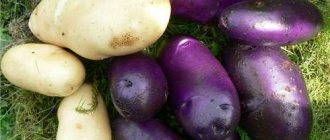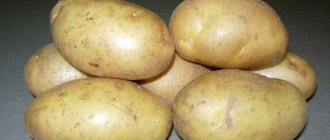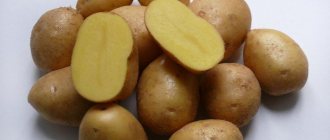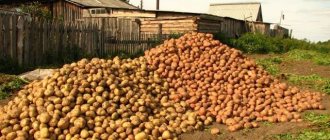Description of the variety and characteristics
At the University of Colorado in the USA, breeders worked for a long time to develop a “cultivated” potato variety with blue-violet flesh.
Origin of the variety
The homeland of the Purple potato is South America, or more precisely, a village in the Andes mountains. It is noteworthy that this potato was bred without any genetic intervention. After some time, the variety “reached” Europe.
In Russia, the first attempts to breed Purple Potatoes were made in Siberia. It was here that potatoes of various colors were bred. But the “mission” was crowned with success only in 2011 in Tomsk. The materials used were brought from Korea.
Today you can find many varieties of purple potatoes. The most popular of them include: Vitelotte, Negro, Gypsy, French violet. They differ only in color saturation.
They have one thing in common - all these varieties are very healthy, and contain much more various nutrients than ordinary potatoes.
Composition and calorie content
Main characteristics of the variety:
- The average size of tubers is 90-14 g;
- Shape – round, slightly oval;
- Tubers are smooth, glossy;
- The peel is thin, purple in color;
- The pulp also has a purple color of less intensity;
- Starch content is about 13%;
- Contains proteins, iodine, a lot of vitamins, and other useful substances.
Important
! Purple potatoes are a very high-calorie product. The taste is reminiscent of regular potatoes, but the texture of the fruit is creamy, and you often come across potatoes with a nutty flavor.
Varieties
Let's look at the most successful and popular varieties.
Witelot
In the original – Vitelotte – one of the most popular varieties with blue-violet pulp. It is also called “Negress”, “French truffle”. The tubers have an elongated shape. The core is intensely colored. The peel is dark. The mass of tubers is small - on average from 70 to 100 g. Late variety - ripening period up to 110 days. Potatoes store well and for a long time, retain their color under any heat treatment, and have a rich taste.
All Blue
This is the direct name, translated from English All Blue, from which it immediately becomes clear what color the flesh of this vegetable is. Although, it is more blue-violet than blue, and the peel is dark purple. There is a light ring between the skin and the pulp.
The variety is mid-early, ripens in 80 days. The tubers are rather large - up to 200 g, but they are not stored for very long. This variety is widespread throughout Europe, it is just beginning to approach us, but it is quickly gaining popularity because it has an excellent taste. It is considered dietary in properties. It contains a lot of antioxidants. The interesting color is completely preserved during frying and baking and fades a little when boiled.
Explosion
This variety is Explosion, so named for its early and rapid fruiting. Early ripening, which will delight you with a harvest within 65 days after planting, has pure purple pulp and the same peel.
The weight of the fruits varies - from 100 to 150 g. The shape is elongated. The difference between this variety and other purple varieties is its increased resistance to disease. It is also characterized by high productivity. You won’t be able to store the fruits for a long time, but you can cook anything from them. You can even eat the vegetable raw, for dietary salads.
Lilac
This variety was bred in Russia by domestic breeders. Mid-season, ripens in 95 days. The fruit has purple flesh and skin. The shape is oval-round. Weight - up to 80 g. It has an average yield, good shelf life and resistance to scab and cancer. The taste is excellent, with a hint of almond. It is considered a valuable dietary product.
Peruvian purple
Purple Peruvian is the original name of this variety, which arose as a result of two centuries of selection by potato growers living in the highlands of the Andes. Just think, for two hundred years people have been trying to develop these elongated eyes covered with many eyes for humanity.
For what? So that people can enjoy a healthy and dietary product by replacing regular potatoes, which are called “second bread” in many CIS countries. Late variety.
Ripens in 100-110 days. And it is no different in size - the average weight of a root crop is 80 g. The yield is also not the highest. But the taste is wonderful. Walnuts and hazelnuts are clearly visible. A very big difference from regular potatoes. Just a new look at the product.
The variety is stored very well and for a long time. It also transports well. And it retains all its beneficial dietary properties almost until spring. It does not lose them during heat treatment. Real food is medicine.
Adirondack blue
The name in its homeland is Adirondack Blue. Bred at Cornell University. It is distinguished by its highest yield and oval-rounded fruits, the average weight of which is about 100 g. The best purple chips can be obtained from the tubers of this variety. Ripening time is average - about 95 days. It is not resistant to diseases and has an average shelf life. But it contains enough antioxidants to make it preferable to traditional neutral-colored potatoes.
Should you grow purple potatoes? Definitely yes. And even if you don’t have room to roam around on your property, and no room for experiments, select a bed for a vegetable of a new color, displacing the good old potatoes. Select variety and ripening time. For example, if you traditionally grow a specific variety of winter potatoes, plant several rows of purple early ripening ones. And see what happens.
Already today there are private farms (not industrial ones) that have switched entirely to growing colored potatoes. It doesn't have to be purple. There are pink, blue, orange varieties. Each of them has its own exceptional beneficial properties. And the table and menu become more interesting, colorful and festive. Color is health. Why not grow a healthy product, even if it is an unusual purple color?!
Advantages and disadvantages of the variety
Like all other potato varieties, Purple has its pros and cons. Let's take a closer look at them.
Positive qualities of purple potatoes
Firstly, Purple Potatoes are an opportunity to decorate the table as beautifully as possible. With its help you can create a wide variety of “compositions” of dishes.
Secondly, boiled Purple potatoes have a blue tint, and their taste is almost always the same as regular ones. So, the dish turns out to be very attractive in appearance, but its taste properties do not change.
The most important thing is that this potato variety contains anthocyanins, which give it its color. It was this fact that interested breeders so much. After all, these substances have practically healing properties.
Main sources of anthocyanins:
- Pomegranate;
- Currant;
- Mulberry;
- Blackberry;
- All other fruits are purple.
Anthocyanins are glycosidic substances, and their color is due to the fact that they are in a pH environment. The latter contributes to the color of the fruit becoming reddish. And, if you add vinegar or lemon juice to purple potatoes, it will change its color.
Contraindications for purple potatoes
Purple potatoes have absolutely no contraindications. Quite the contrary - it is recommended to add it to the diet of those people who suffer from:
- Diabetes mellitus;
- Hypertension;
- Cardiovascular diseases;
- Intoxication of the body;
- Reduced immunity;
- Any inflammatory pathologies.
Dishes made from colored potatoes
Colored potatoes are prepared in the same way as regular ones, but mashed potatoes and pancakes turn out much more beautiful, as they retain their bright color after heat treatment. The same can be said about colored salads and fresh healing juice. The taste of colored potatoes is the same as regular ones. True, some red varieties have a ginger flavor, while purple potatoes have a richer taste. New potatoes can be prepared in any way: frying, boiling, steaming or baking. To prevent the potatoes from losing color during the cooking process, you need to cook them for no more than 20 minutes and in salted water. Colored varieties also make delicious potato pancakes, better known as Belarusian pancakes, Ukrainian potato pancakes or Polish plyatski. In our country you rarely see chips made from potatoes on sale - mostly from all kinds of substitutes. And even more so from colored people. Therefore, you can make colored chips yourself. Peel the potatoes and cut them into thin slices. Soak in water for half an hour. Dry on a towel. Place on parchment paper and microwave for 4 minutes. And the chips are ready. For salad, colored potatoes are boiled in their skins. Salads with red, blue or purple cubes look impressive. But, of course, this is not the main thing - colored potatoes contain anthocyanins. These substances prevent the development of many diseases and in particular cancer. Therefore, preparing food from colored potatoes is very useful. If you live in an area where there is a lot of gas pollution or work in a harmful environment, then eat cauliflower potatoes boiled in their skins more often. With this preparation, starch catches and removes various harmful compounds from the body.
How and where to grow purple potatoes
Proper care and compliance with all planting rules are the main factors on which the yield of this variety depends. The planting site should be chosen so that the area receives a lot of sunlight. The best option is the southwest of the garden.
You may be interested in: Dates for planting potatoes in 2021 for central Russia and the Moscow region Dates for planting potatoes in May-June 2021 according to the lunar planting calendar Favorable days for planting potatoes in 2021 according to the lunar calendar
Soil preparation
The soil should be light so that the plant has constant access to oxygen. Water should also not stagnate - its normal outflow must be ensured.
It is the light soil that can cope with this. Therefore, such potatoes will grow best on sod-podzolic, neutral, loamy and floodplain lands.
In order for the plants to take root and the fruits to form correctly, you need to carefully dig up the place for future planting of potatoes. It is better to carry out the first digging before winter.
The fact is that all large lumps of earth, lifted with a shovel, will remain at the top, and as soon as frost “hits”, all harmful larvae and bacteria will die.
Planting and care
Purple potatoes should be planted in the spring, when the soil warms up to at least +5 degrees. First, the soil must be dug up, loosened, holes prepared for the tubers, and wood ash added to them.
Wood ash is not just a storehouse of useful microelements. It is considered an excellent disinfectant that helps prevent a lot of potato diseases.
The holes must be made so that their distance relative to each other is at least 35 cm in a row. Between the beds you need to maintain a distance of at least 65 cm.
If the plants are planted in hard soil, it must first be mixed with river sand. The holes should be 10 cm deep.
It is easy to care for the plants - they need watering every 7 days (if there has been no precipitation). When a crust forms on the ground, it must be thoroughly loosened. If the soil is wet, it can cause the development of various diseases. Therefore, this “parameter” also needs to be monitored.
Of course, this variety of potato also needs systematic feeding, treatment with drugs against late blight and various pests. The procedure is carried out according to the instructions for the substance.
Potato varieties with purple skin
Blue Danube is a mid-early variety, the period from the appearance of the first shoots to ripening is 65–80 days. Potatoes are drought and disease resistant. The skin of the tubers is dense, so they suffer little damage when digging them up either manually or with a walk-behind tractor. Productivity – 340 – 400 kg per hundred square meters. The pulp is white and does not darken during heat treatment. Since potatoes are tasty, but difficult to boil, they are recommended for frying, making soups and salads.
Blue Danube
Gypsy is a mid-early variety that is not included in the register. The tubers have smooth, dark purple skin and white or light cream flesh, sometimes with purple veins. 6–14 tubers are formed under the bush, but they often differ significantly from each other in weight and size. Productivity – 200–250 kg per hundred square meters. The variety is highly susceptible to diseases and requires watering. Due to the fact that the peel is very thin, potatoes can only be dug out by hand.
Gypsy
Diseases
The purple potato variety is immune to the most common crop diseases: cancer, rot, scab. Shows average resistance to late blight. Also, treatment for pest beetles may be necessary.
As a preventive measure, before planting potatoes, you need to treat the planting material with potassium permanganate. It is also important to change the planting location every few years and alternate the crop with legumes, cabbage, and phacelia.
Click beetles and Colorado potato beetles are the main enemies of this variety. They spoil the tops, reduce yields, and negatively affect the keeping quality of potatoes and their appearance. Therefore, you need to get rid of them with the help of insecticides.
The benefits of potatoes
Is it healthy to eat these potatoes? As previously mentioned, the composition of purple potatoes is quite rich, since it contains many rare minerals and vitamins. Eating such a vegetable as food will give you additional strength to fight various kinds of diseases; consumption of such a vegetable is especially useful for those who suffer from diseases of the heart system.
It is worth mentioning that the composition contains antioxidants, so we can conclude that regular consumption of this product will help slow down the aging process in the body. It is impossible not to say that potatoes contain ascorbic acid, the benefits of which probably every person knows.
The vegetable is colored blue due to the presence of special pigments. It is worth saying that they affect not only the color of the tubers, but also change the chemical composition of the vegetable, making it even more useful. So, we can say that the pigments present help the body get rid of free radicals, that is, the antioxidant function is enhanced, as well as detox.
Due to the fact that the product contains dietary fiber, we can safely say that consuming such potatoes will improve the functioning of the digestive tract, this is especially true for those who have problems in this area. Some say that with regular consumption of this type of potato it is possible to lose excess weight, that is, the vegetable can be called dietary.
Contraindications
When talking about any product, especially such an unusual one, one cannot help but talk about possible contraindications. It is not recommended to eat purple potatoes in the following cases:
- First of all, it is not recommended to include this vegetable in the diet of those who suffer from low blood pressure or hypotension.
- In addition, the consumption of vegetables is strictly prohibited for those who have an individual intolerance to the product, that is, an allergy. You can suspect its presence if you have had symptoms of allergies when consuming products such as plums, eggplants, and others that are colored purple.
Reviews
Maria Petrovna, 32 years old, Nizhny Novgorod
“The year before last we planted these potatoes in our dacha. The fruits themselves are very interesting and attractive. Once the children and I fried these potatoes over a fire. They were simply delighted with the unusual coloring. Yes, and the taste is amazing!”
Petr Nikolaevich, 40 years old, village. Forest
“I've heard a lot about this variety. Especially positive ones. But I haven’t tried planting it myself yet. Thank you for the article! This year I will definitely try to grow purple potatoes in my garden.”
Dietary and healthy product
Regular potatoes can hardly be considered a dietary product. In contrast, its purple counterpart is not as high in calories, and also contains much more beneficial properties. These include:
- High content of vitamins C and E, the presence of carotenoids directly involved in the synthesis of vitamin A.
- Lowers blood pressure, which is very useful for hypertensive patients. But people with hypotension are not recommended to use it.
- A large amount of antioxidants in the pulp - substances that slow down the aging process.
- Improving metabolism, restoring the elasticity of the walls of blood vessels, which reduces the risk of strokes and other diseases of the cardiovascular system.
- Normalization of hormonal levels.
- Reducing exposure to carcinogens and radiation on the body.
- Improved vision.
Purple potatoes absorb nitrates from the soil less actively.
Benefits and harms
Purple tubers are a storehouse of antioxidants, potassium and calcium, vitamins C and E, carotenoids, and phenolic acids. Widely used in dietary nutrition. Tubers have a lot of beneficial effects :
Normalizes high blood pressure.
- Strengthen arterioles and prevent atherosclerosis.
- Prevents the appearance of tumors.
- Slow down aging.
Among the negative points:
- It is undesirable to use hypotonic drugs in the diet.
- Increased individual sensitivity.
Potato variety Violet: characteristics and description, reviews, photos
06/27/2019 Victor Karseko
Recently, a new exotic purple potato variety has appeared on grocery store shelves. It has become widespread among summer residents, thanks to its unusual appearance, taste and beneficial properties. You can grow it on your site by thoroughly studying the characteristics of the tubers and following the rules of agricultural technology.
Features of planting and care
The main feature is the seed planting method. In order to grow purple-fleshed potatoes yourself, you need to germinate the seeds and only then place them in the soil. Despite the simplicity of planting, it is worth saying that not all planted seeds will sprout, but only half of them. In order for the seedlings to take root, it is recommended to plant them in April, while transferring them to open ground occurs closer to May.
It is worth saying that purple potatoes are more resistant to diseases and various kinds of parasites after planting.
As for the description of caring for the crop after planting, it is not too different from the usual activities. For this variety, as for others, hilling is recommended. When choosing fertilizer, it is best to give preference to humus; it is most suitable for a given crop. It is important to ensure that during the seedling period the seeds are placed in high-quality soil, this will prevent the appearance of mold. The unusual potatoes are harvested at the end of summer, usually in mid-August.
Photos and descriptions of varieties of lilac root vegetables
There are more than 120 varieties of blue-violet potatoes. All types of purple root vegetables contain a natural pigment that gives them an exotic color. For breeding, scientists used maternal varieties from South America and locally bred varieties – Exotic, Tiras.
Early
Valued for its delicious taste and marketability. Used for fresh salads and assorted vegetables. The most popular varieties.
Explosion
The shape of the tubers is elongated. Highly productive variety with blue-violet skin and pulp. Among the advantages are good productivity and strong immunity. The variety is not suitable for long-term storage .
Explosion
High-yielding potatoes. Weight ranges from 90-140 g. Ripens 65 days after germination. Excellent taste.
Meteor
Shows high productivity. Weight from 90 to 120 g. Can be consumed raw, in dietary salads.
Solokha
Round-oval shape. The pulp is anthocyanin, the skin is black and purple. Productivity 38-40 tons per hectare. Tuber sizes are 4-5 cm. Starch level is 20%. The variety has resistance to scab and late blight .











